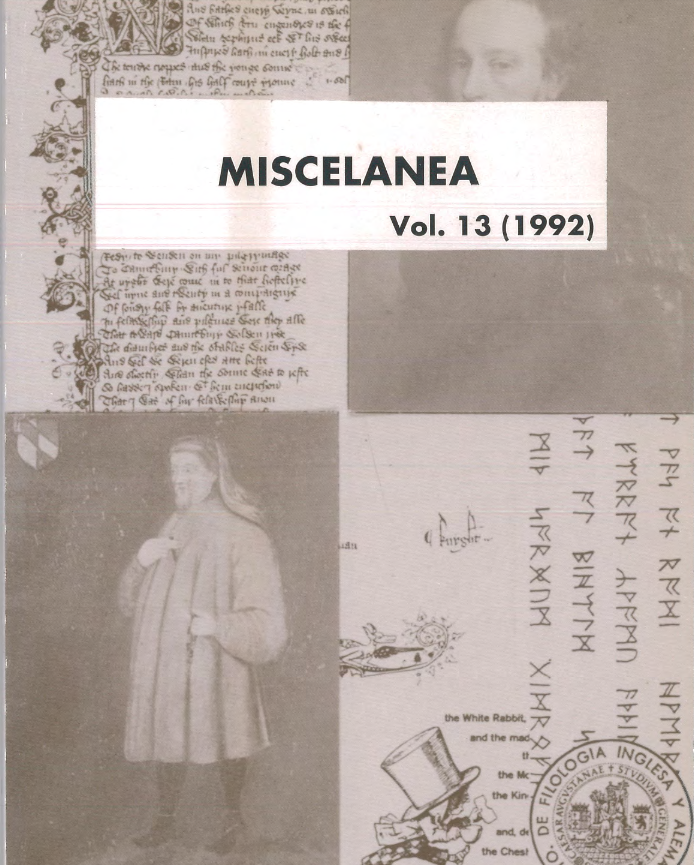Ciclos creativos en la poesía de James Joyce
DOI:
https://doi.org/10.26754/ojs_misc/mj.199211794Abstract
This essay attempts to distinguish between two considerably different creative impulses within Joyce's poetry that give rise to his book Chamber Music [1907] and Pomes Penyeach (1927). We analyse the former as a conscious and youthful effort on Joyce's part to make his name as a poet. Hence, his care for style, contrived versification, purity of diction, and impersonality under the welcome influence of the Elizabethan collections of lyrical verse, Shakespeare's dramatic work, and the biblical Song of Songs. After twenty years of struggle and some bitter disappointments, Joyce's poetical mood altered noticeably. Pomes Penyeach is not the result of an intent purpose to compose a’ systematic book, but rather a collection of occasional poems directly derived from his experience. His formal rigour also relaxed, and personal confession replaced stylistic aloofness. In conclusion, both books seem to be poles apart, save for a common denominator: the stubborn intensity with which they incorporate material borrowed from Shakespeare, the Bible, Dante, Nashe, and others.
Display downloads
References
ANDERSON, Chester G. 1958. “James Joyce's Tilly”. PMIA 73: 285-98, DOI: https://doi.org/10.2307/460246
DIETZ, Bernd. 1982. “Relectura de la obra poética de James Joyce”. En Francisco García Tortosa, et al., eds. James Joyce: A New language: Actas / Proceedings del Simposio Internacional en el Centenario de James Joyce. Sevilla: Publicaciones de la: Universidad de Sevilla. 27-37.
ELLMANN, Richard. 1959. James Joyce. New York: Oxford UP.
GORMAN, Herbert. 1940. James Joyce. New York: Holt, Rinehart and Winston.
GUIDI, Augusto. 1954. Il primo Joyce. Roma: Edizioni di Storia e Letteratura.
JOYCE, James. 1954. Chamber Music. Ed. William York Tindall. New York: Columbia.
---. 1964. A Portrait of the Artist as a Young Man. london: Jonathan Cape.
---. 1986. Ulysses: A Critical and Synoptic Edition. Eds. Hans Walter Gabler, Wolthard Steppe y Claus Melchior. New York: Garland.
JOYCE, Stanislaus. 1982. My Brother's Keeper. Ed. Richard Elimann. London: Faber and Faber.
LAWSON, David. 1986. “Chamber Music XXXVI as Prototaxic Experience”. James Joyce Quarterly 24: 83-85.
LEVIN, Harry, ed. 1981. The Essential James Joyce. London: Granada.
LOBNER, Carina del Greco. 1972. “James Joyce's ‘Tilly’ and Gabriele D'Annunzio's ‘I Pastori d'AbruzJamzeso ” Joyce Quarterly 9: 383-89.
The Oxford English Dictionary. 1970. Oxford: Clarendon. 12 vols.
READ, Forrest, ed. 1968. Pound / Joyce: The letters of Ezra Pound to James Joyce, with Pound's Essays on Joyce. London: Faber and Faber.
REYNOLDS, Mary T. 1976. “Joyce's Villanelle and D'Annunzio's Sonnet Sequence”. Journal of Modern Literature 5: 19-45.
RYF, Robert S. 1962. A New Approach to Joyce: The Portrait of the Artist as a Guide Book. Berkeley: U of California P. DOI: https://doi.org/10.1525/9780520376106
SCHOLES, Robert. 1965. “James Joyce, Irish Poet”. James Joyce Quarterly 2: 255-70.
SHAKESPEARE, William. 1980. Macbeth. Ed. Kenneth Muir. The Arden Shakespeare. London: Methuen.
---. 1980. As You like It, Ed. Agnes Latham. The Arden Shakespeare. London: Methuen.
SHAWCROSS, John T. 1969. “Tilly' and Dante”. James Joyce Quarterly 7: 61-64.
SLOCOMEBE, George. 1936. The Tumult and the Shouting. London: Heinemann.
TINDALL, William York. 1952. “Joyce’s Chambermaid Music”. Poetry 80: 105-16.
WILLIAMS, Martin T. 1952. “Joyce's Chamber Music”. The Explicator 10: item 44. DOI: https://doi.org/10.1080/00144940.1952.11481625
Downloads
Published
Issue
Section
License
Copyright (c) 1992 Jose Antonio Álvarez Amorós

This work is licensed under a Creative Commons Attribution-NonCommercial 4.0 International License.


